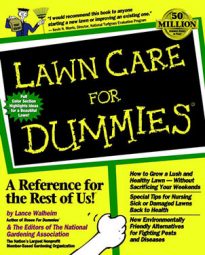If you live in a warm climate, you should choose from among these commonly used warm-season grasses: Bahia grass, common and hybrid Bermuda grass, centipede grass, St. Augustine grass, and zoysia grass. Whether you live in Florida or California, chances are that your lawn has one or a combination of these grasses growing in it:
Bahia grass: Bahia grass (Paspalum notatum) is a tough, coarse grass that roots deeply and extensively. This grass sends out runners that can help stabilize erosion-prone soil. Bahia grass is low-growing and forms a tough, open turf that resists thatch. Bahia grass has excellent wearability, but gets a high-maintenance rating in the mowing department. You need to mow frequently with sharp blades.
Bahia grasses are shade-tolerant, moderately drought-tolerant, and do well in sandy or infertile soils of the southern coastal plains of the United States. These grasses stay green longer than most of the warm-season grasses over the winter months.
Bermuda grasses: You can choose from two Bermuda grasses:
Common Bermuda grass: Common Bermuda grass (Cynodon dactylon) is a medium green, medium- to fine-textured turf. The grass roots deeply and spreads quickly, making it heat- and drought-tolerant. The rapid spreading can cause a problem of invasion into unwanted areas if not kept in check. This turf has excellent wearability, however, it doesn’t do well in shade and turns brown in winter until daytime temperatures reach a consistent 60 degrees F. Common Bermuda grass grows well in poor soils.
Hybrid Bermuda grass: The hybrid Bermuda grasses (Cynodon dactylon crossed with C. transvaalensis) are softer, denser, greener, and more finely textured than the common Bermuda grasses. Hybrid Bermuda grass is heat-loving, fast-growing, drought-tolerant, and very durable, making it a good choice for high-traffic lawns. The hybrid types are more disease- and pest-resistant than common Bermuda grass, but thatch buildup can become a problem.
Centipede grass: Centipede grass (Eremochloa ophiuroides) is a medium- to fine-textured, light green grass that spreads by creeping stolons. This grass has shallow roots, making it only moderately tolerant to drought, slow to fill in as a lawn, and slow to recover from wear and tear. Centipede grass is not a high-traffic-area grass. However its good resistance to disease and pests make it a good, low-maintenance lawn grass. It’s one of the first of the warm-season grasses to turn brown in hot, dry weather and to go dormant with the arrival of winter. This grass tolerates moderate shade, but doesn’t tolerate the salt from sea spray. Centipede grass can turn yellow in alkaline soils that lack iron, but greens up with applications of iron sulphate or iron chelate.
St. Augustine grass: St. Augustine grass (Stenotaphrum secundatum) is a fast-growing, deep-rooted, coarse to medium-textured grass with broad, dark green leaves. The grass spreads rapidly by surface runners that form a thick, dense turf, giving this grass an A for wearability.
This grass is quite popular in southern climates, from Florida to California, because of its tolerance to heat, sun, shade, and salt. St. Augustine grass can grow in most soils, but prefers well-fertilized, well-drained, alkaline soil.
St. Augustine grass is susceptible to brown patch, mole crickets, sod webworm, chinch bugs, and a virus called St. Augustine Decline (SAD, for short).
Zoysia grass: Zoysia grasses are fine- to medium-textured, dark green, and moderately deep rooted. The blades are wiry, making them the least comfortable lawn for barefooted traffic. You generally plant zoysias by plugs, which may take two seasons to fill in your lawn space. However, when the plugs spread out and the space gets covered, you end up with a fairly low-maintenance lawn that can withstand high traffic.
When properly cared for, zoysias are fairly pest- and disease-resistant when compared to other warm-season grasses. However, brown patch, dollar spot, armyworms, billbugs, and sod webworms can occasionally create problems if you slack off on maintenance. Ditto thatch.
The Native Grasses: North America’s native American grasses are growing in popularity among more environmentally conscious lawn lovers because of their lack of demands on precious resources and labor. For the most part, native grasses need little water once established, very little fertilizer, and a haircut only a few times a year. The two most popular warm-season native grasses are blue grama and buffalo grass:
Blue grama: Although this grass goes dormant, it tolerates extreme heat and cold and does well in the arid regions of the Central Plains. Blue grama is very drought-tolerant and offers moderate wearability, but is slow to recover from wear damage.
Buffalo grass: Buffalo grass is drought-tolerant once established and becomes even more so if mowed infrequently and high. This grass thrives in areas that receive only 10 to 15 inches of rain a year, but will go brown if allowed to go completely dry. More lawnlike in appearance than other natives, buffalo grass is becoming quite popular in drought-prone regions. However, it’s expensive to plant, whether by seed, sod, or plug.

